
October 6, 2001 - The New York press file endures in bare bones fashion (clippings online, but text and tables still pending).
Coming soon: additional reviews from Vancouver, San Francisco, Hollywood, Kansas City, Minneapolis, Washington, Charlotte, Akron, Indy, Toronto, Montreal, Boston, and Pittsburgh, plus bonus Warwick clippings

The fabled summer 1972 tour through the U.S. and Canada is revered by Stones fans worldwide as arguably the band's greatest ever, and it remains enshrined in the annals of rock lore and popular imagination as the masterpiece speedball of indoor triumph, outdoor maelstrom, and backstage debauch. In powerful testament to this enduring sway, vast quantities of audio recordings, books, magazines, photographs, films, videos, and other memorabilia have since issued through licit and sub-licit channels to keep the coveted sights and sounds of the Stones Touring Party alive, rolling, and fresh to this very day. Yet despite all the inside exposes from the likes of Robert Greenfield, Richard Elman, Terry Southern, and Robert Frank, all the global commerce in concert tapes and discs, and all the redoubtable registries of expert chroniclers such as James Karnbach, Felix Aeppli, and Nico Zentgraf, there are still considerable gaps in our baseline knowledge of the songs actually played in several tour cities. This multi-part article seeks to advance Stones scholarship by filling in at least some pieces of these missing, unverified sets with convincing evidence from a fresh trove of tour documents.
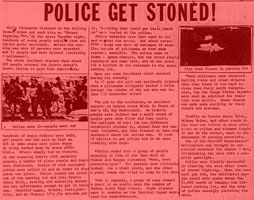
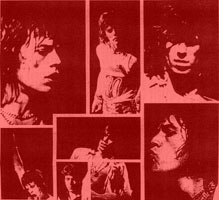
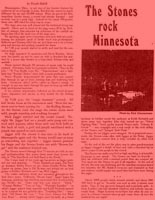
Until now, STP sets have been established almost exclusively from audio tapes, with occasional assists from national journalists or tour films. These conventional sources have brought us a very long way, for sure, but tapes of several shows remain incomplete, unavailable, or nonexistent, and further progress in our traditional sets work will come ever more slowly as the store of undiscovered or uncirculated audience recordings eventually dwindles to an unyielding, empty core. Indeed, for a measure of the increasingly difficult work that looms ahead, consider this partial inventory of cities with unbooted performances and still uncertain set pedigrees: San Francisco, San Diego, Denver, Minneapolis, Chicago, Houston, St. Louis, Detroit, Toronto, Philadelphia, New York.
Fully one third of the entire STP concert run remains trapped behind these mystery gigs, and unwary is the observer who assigns the common tour playlist to them through default, conjecture, or reference to alleged insider knowledge. In recent years, as we know, newly surfaced audience recordings of shows in Fort Worth and San Francisco have revealed startling performances of previously uncited songs. These revisionist surprises demolished portions of the conventional wisdom about the 1972 repertoires, undermined the authority of one "ultimate" Stones reference work, and raised at least mild hopes of finding additional gems along the tour trail. Since, for example, Karnbach and Bernson's It's Only Rock 'N' Roll was so mistaken about which tunes were laid down at the final Winterland concert (no mention therein of Loving Cup or Honky Tonk Women), one cannot but wonder how many more of its concert entries lack solid foundation and obscure the true variety of STP playing. (Alert to owners of said volume: be prepared to inscribe still more corrections to pages 137-140.)
So, beyond pining for new tapes, what can a poor boy do? Well, I propose we direct his marching, charging energies to an indoor exercise of grassroots historical detection, taking latter-day advantage of the coast-to-coast tumult of fan mania, municipal fear, arena mayhem, celebrity arousal, and media saturation that made the tour such an irresistible draw. That is to say, rather than waiting still more decades for the final pieces of the concert recordings puzzle to emerge from fan shoeboxes or official vaults, let us employ a ready, substitute method of sets assembly that builds from a rich but hitherto untapped store of public artifacts: the substantial (and thankfully preserved) paper trail of local press reports about the concerts.
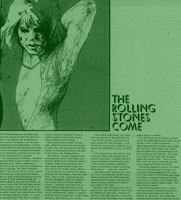
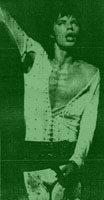
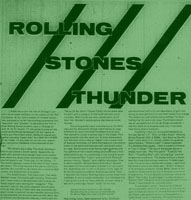
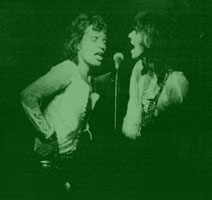
By now, the few dozen extant audience and soundboard recordings from 1972 have been deconstructed quite exhaustively, but the much larger corpus of concert documentation from daily and weekly newspapers all across North America has not yet been systematically mined for song data. In those days, most tour cities still had morning and afternoon dailies, plus at least one "underground" weekly, and the unprecedented hype and trepidation swirling ahead of the Stones Touring Party made sure that all of these outlets, even the ones otherwise disdainful of rock culture, sent a reporter and a photographer out to cover the show when it rolled into town. This fortunate confluence typically generated three or more separate concert reviews from which we can now glean song references for each venue.
Expecting that overlapping local newspaper articles could offer some credible evidence for incremental reconstructions of tour sets in cities for which no definitive audience tapes are yet available, I began many months ago to collect, analyze, and cross-check numerous "establishment" and "underground" press reviews of the concerts from San Francisco through Houston. Initially, I planned to concentrate solely on the early, western venues owing to their somewhat more varied set histories, and thus their correspondingly greater chances of revealing additional "surprise" output a la the recent June 8 evening and June 24 afternoon audience tapes. But my first forays into library microfilm revealed so many intriguing concert details that I soon extended the project to cover the entire tour (and more than just songs).
After twelve months of intermittent research visits and queries to libraries near and far, I have gathered a fertile, perhaps unprecedented, archive of more than 200 STP articles, with at least two review pieces for every city. When read together for the first time, these hitherto isolated newspaper accounts often mesh instantly to corroborate some published STP retellings, settle a few venerable audio mysteries, illuminate many new performance details, and even unearth two "lost" gigs never credited in the standard tour chronologies. (Quite frankly, I was most "shocked, shocked" by how little investigation it actually took to discover these two missing concerts - which were ripe for the picking courtesy of open clues from Greenfield - and what their easy recovery this late suggests about the prior art by some published Stones authorities.) Without unveiling all of the researched spoilers right now, among the major revelations that will be presented in this serialized article are:
Some very curious song references in the available literature will be tackled as well, and interested readers are welcome to contact me directly to share perspectives, interpretations, resources, and such. (An enhanced version of this article, complete with reference scans of key clippings, will be posted here soon.) Overall, the complete Vancouver-to-New York findings will probably not reverberate through our globalized fan networks like a perfect 1970 soundboard, but they should make welcome, marginal advances in our present-day understanding of the STP and its celebrated musical legacy.
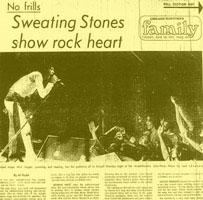
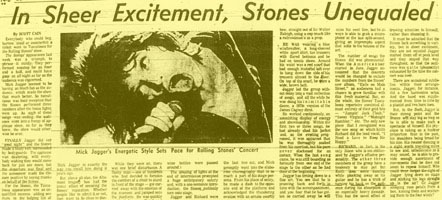
In the best of all possible Stonesworlds, it would not be necessary to scrounge any American Tour 1972 sets from press clippings alone, for we fans would already be luxuriating in full-length, official CDs of every performance. And outfitted with this mythical "Mick's Picks" mega-box, we could comfortably devote our trainspotting talents elsewhere, say to dissecting the technical nuances of Taylor's guitar work in Denver versus Detroit. As matters stand in the real world, of course, we do not even have complete unofficial recording coverage of the tour, and thus are left to fill in the many numbers gaps with the best public evidence at hand, the accumulated archives of eyewitness and ear-witness reviews from across the land.
My reconstruction process has been guided by two principles, one based on the known history of the Stones performances and the other drawn from the inherent limitations of concert reporting. It is well known that, after the tour starters in Vancouver and Seattle, a typical Stones set comprised these 15 songs in this sequence: Brown Sugar, Bitch, Rocks Off, Gimme Shelter, Happy, Tumbling Dice, Love In Vain, Sweet Virginia, You Can't Always Get What You Want, All Down The Line, Midnight Rambler, Bye Bye Johnny, Rip This Joint, Jumping Jack Flash, Street Fighting Man. On a very few occasions, the band would add a different song (or two), but these 15 formed a predictable core. Jagger himself admitted such near the end of the tour, lamenting, "It was kind of disappointing to find we couldn't vary the show more. When we try to stick in a few extra numbers, the whole show kind of tilts out of balance. We kept to the sequence that felt best for the show." For this reason, one press mention of any of the core songs is considered sufficient to confirm its performance that day.
On the other hand, one must approach the reviews with caution when non-core songs are reported. After all, the local reporters were fallible observers who probably lacked complete familiarity with the band's full concert repertoire, especially the recent album cuts that had never saturated the radio airwaves. Indeed, more often than not, known instances of rare tunes being played are not documented at all in the available press, and local writers may have committed to ink innocent title misnomers that we should not seize upon as substantiated "proof" of major sonic discoveries. For example, none of the three reviews from Fort Worth mentioned Sweet Black Angel or Don't Lie To Me (although one critic there did catch Dead Flowers), and five Vancouver reviewers failed to cite the exalted June 3 triumvirate of Loving Cup, Torn & Frayed, and Ventilator Blues. Likewise, a single, anomalous report of, say, Wild Horses or Sympathy For The Devil being played (stay tuned!) would be considered insufficient to establish true presence. For the purposes of this exercise, two independent reports of a non-core song are necessary for verification.
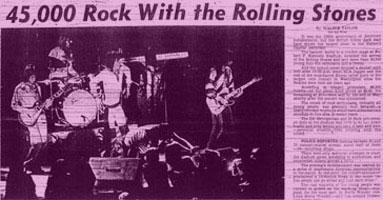
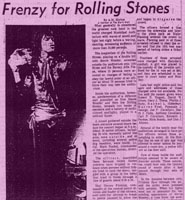
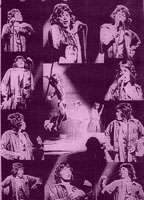
My presentation of the research evidence and findings begins with city-by-city concert profiles covering Vancouver through Minneapolis; the balance of the tour will be examined in three subsequent installments. Each venue write-up contains a table of show details extracted from the available clippings, with the first cells displaying the song references made by the reviewing articles. (Song arrangement in the tables conforms to the known or standard show sequencing rather than to the order of appearance in the articles, which is almost always rather nonlinear.) In cases of unbooted performances, the various threads of press evidence are then woven into composite set re-creations. Other table sections quote related performance markers such as wardrobe, staging, encores, and opening acts. The written descriptions of Jagger's costumes are often wonderfully vivid and can serve to confirm or correct the true provenance of tour film clips and photographs. In addition, we will see numerous credible references to encore numbers and opening acts (other than Stevie Wonder) not registered in Karnbach's book. Tour stops with presumably definitive tapes are treated anyway to build confidence in the press as a reliable proxy, and to reveal the targeted concert visuals that audio does not capture.